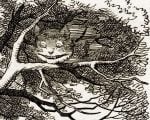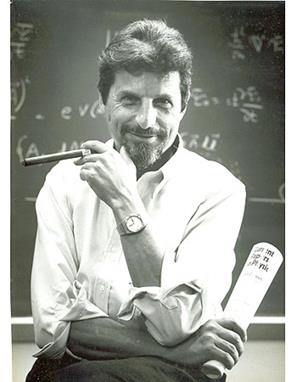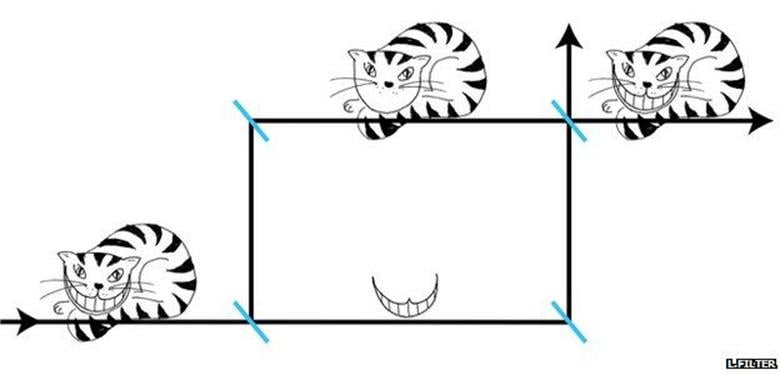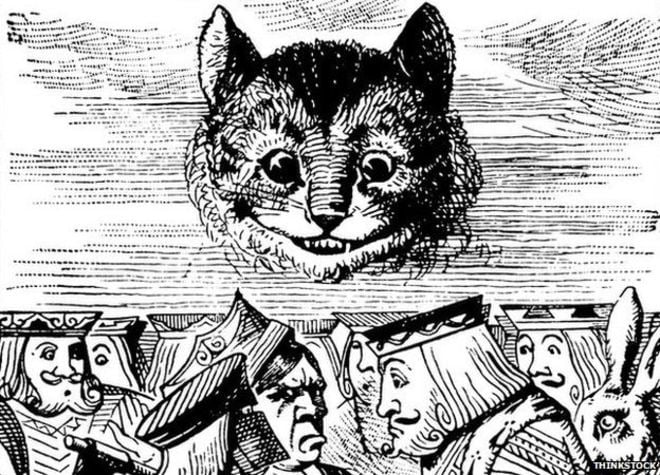In memory of my father, Abraham Shamshin ben Reuven, ע”ה
For those of us who can’t get enough of Schrödinger cat, comes a new feline—Quantum Cheshire Cat—the creation of an Israeli physicist, Yakir Aharonov.
In Alice in Wonderland, Alice meets a grinning Cheshire cat.

To her amazement, the cat disappears leaving only his grin behind:
“All right’, said the Cat; and this time it vanished quite slowly, beginning with the end of the tail, and ending with the grin, which remained some time after the rest of it had gone. Well! I’ve often seen a cat without a grin, but a grin without a cat! It’s the most curious thing I ever saw in my life!”


According to Martin Gardner, the statement “a grin without a cat” is a reference to mathematics dissociating itself completely from the natural world. ( Gardner, Martin (1999). The Annotated Alice: Alice’s adventures in Wonderland & Through the looking glass). It seems to me, “a grin without a cat” may also be a reference to a soul disassociating itself from the body.
This metaphor begs the question, how does a soul find the body it was associated with upon resurrection of the dead? This question was raised by Rabbi Aryeh Kaplan in his book, Immortality, Resurrection and the Age of the Universe: A Kabbalistic View. Rb. Kaplan cites an opinion of the sages that the resurrection of the bodies may be done by the chachamim (sages or, according to Rb. Kaplan, contemporary scientists). It will take the Divine intervention to match the “right” souls with the “right” bodies.
In Kabbalah and Chasidic philosophy, the resurrection of the dead is not only viewed as the greatest miracle of all but, indeed, the very purpose of the creation! At that time, G‑dliness will be revealed, as the prophet said, “And the glory of the Lord shall be revealed, and all flesh shall see it together, for the mouth of the Lord hath spoken it.” (Isaiah, 40:5)
I don’t mean to imply that the resurrection of the dead will be anything less than the greatest miracle. However, as we approach this time, we find the hints of it in the physical world and, first and foremost, in quantum physics.

Yakir Aharonov
Quantum Cheshire Cat was predicted by Yakir Aharonov in 2013. According to this prediction it should be possible to separate a quantum particle from (and then reunite with) its properties, i.e., its “personality.” Just as a Cheshire Cat can be separated from its grin, so a quantum particle may be separated from one of its quantum characteristics, such as a charge, a spin or magnetic momentum. Aharonov and his colleagues envisioned a thought experiment in which a photon can be separated from its polarization. In this gedanken experiment, a light goes through half-mirror splitting in two beams—one traveling along one path and the other along another path. The setup could be arranged so that the photon striped of its polarization travels along one path and the disembodied polarization travels along another path.
But how do you prove that? We know that measuring properties of a subatomic particle collapses its wavefunction and changes its properties (“the Measurement Problem”). Yakir Aharonov earlier discovered that “weak,” i.e., imprecise measurements, do not collapse the wavefunction. For example, measuring a position and a polarization of a photon simultaneously (“strong” measurement) determines its position and polarization and finds the photon and its polarization in the same place. If, however, you measure the position of one photon and the polarization of another photon, you find that photons travel along one path and the disembodied polarization travels via another path.
To test this theory, in 2014, Tobias Denkmayr and his colleagues at the Institute Laue-Langevin in (ILL) Grenoble, France, send a neutron through an interferometer—a silicon crystal. An interferometer acts, just as half-mirror, as a beam-splitter. If many neutrons are sent through such interferometer, half of them will go one way and half the other way. Neutrons are neutral particles, i.e., their electric charge is zero. However, they have magnetic momentum and a spin.

The neutron (“cat”) goes via the upper beam path, while its magnetic moment (the “grin”) goes via the lower path
The scientists at ILL performing weak measurements on the neutrons going through the interferometer demonstrating that neutrons without its magnetic momenta travel via one path, while the disembodied magnetic momenta travel via a different path. In the end, neutrons and their magnetic momenta happily reunite.
But how can a property exist without its carrier? Have we ever seen a color disembodied from the object having that color, or a shape disembodied from the object having that shape? Already in antiquity, Plato speculated that properties could exist in their disembodied form—he called them “ideal forms.” Plato was once waking with one of his disciples. They saw a horse. Plato turned to his student and asked him: “What do you see?” The student responded: “I see a horse.” Plato replied to him: “I see the ‘horseness,’ the abstract of a horse” Mathematics, in fact, deals with such “ideal forms” all the time. The number 2 doesn’t mean two apples, or two cars or two anything… it’s just the notion of “2-ness” disembodied from whatever object to which it may apply. And so it is with any number and any shape.

Rogachover Gaon
In Jewish philosophy we speak of such concepts as “chomer” (matter) and “tzura” (form). In some context, chomer and tzura represent physical and spiritual; in another context, they represent quantity vs. quality; in yet another context they represent substance vs. form. Tzura is the abstraction, as the Plato’s “horseness.” One can also say that chomer is an undifferentiated matter or raw material, while tzura is the shape and other properties of the object made from this raw material. Iron, for example, is chomer. A knife—it’s shape, properties and purpose—is tzura. The Rogachover Gaon often used the contrast between chomer and tzura to analize the differences between the opinions of Bet Hillel and Bet Shamai. Hillel often emphasized the importance of chomer, whereas Shamai placed the emphasis on tzura. Thinking of a Cheshire cat, we can say the cat is chomer, but its grin is tzura. Translating this to a quantum Cheshire cat, a photon (or neutron) is chomer, and its polarization (or magnetic momentum) is tzura.
According to Kabbala, the human body is chomer, while the neshamah (soul) is tzura. The quantum Cheshire cat represents an excellent metaphor of tehiyat hametim—resurrection of the dead. In many mystical traditions, death is viewed as a mere transition. Borrowing from our quantum analogy, death could be viewed as passing through an interferometer of sorts, a “beam-splitter” where the soul gets separated from the body. From that point on, the lifeless body and the disembodied soul travel different paths only to be reunited at the time of tehiyat hametim—resurrection of the dead. During their separate existence, the body and the soul remain entangled, as it were, which assures that the resurrected body will be matched with its very own soul. May this happen very soon


I wish I understood the physics more. The little I can imagine, helps me so much when you apply it to Torah concepts.
Thank you.
Brilliant and fascinating. May I suggest that this is descriptive of a concept applied, but not prescriptive. I recognize that you did indicate this at the outset (….I don’t mean to imply that the resurrection …) However, it is important to note, about Aryeh Kaplan, that beside the (published) fact that he rants and raves against the Rebbe ZY”A (without mentioning names), which as purely an academic exercise is quite ugly, he develops an amazing digression from the very basics of emunah. I refer to a post-humus work whose title eludes me at this moment, but I do have a photocopy of some of the essentials buried in my research archive (because it added to my motivation to write a book, as yet unfinished 15 years later.) He claims, quite clearly, that Adam and Chava were not the first humans (or humanoids) in order to “fit into” his grand theory of the 14+/- billion years of evolution. The theory is based on a manuscript he found, that was signed “Yitzchak of Acco”, and without equivocation treats it as written by the well known Mekubal (Kabbalist) R.Yitzchak de min Acco. This, of course, requires us to assume that historically there was only one Yizchak in Acco and that the possibility of someone (years later) seeking the countenance of that great and well-accepted scholar. (My personal discomfort was that this was a manuscript found by no one else but…) Due diligence required me to trace the editor of that work, which was not a simple matter, to ask whether there were changes made to the note Kaplan left. He insisted that they changed nothing of the content, but that there were corrections to be made in the citations. If asked a sha’alah, my psak would need to be that his translation of chumash does not belong in a shul, if in fact, it does not require the stricter treatment required for a Sefer Torah shekosvo min. P.S. In the blog http://failedmessiah.typepad.com/failed_messiahcom/2005/07/rabbi_aryeh_kap.html it quotes the source of billions of years to a sefer of R.Yitzchak de min Acco. Only minutes ago did I see that variation (that it was in a sefer.), but given the other inaccuracies of that blog (see comments there) my memory stands on firmer ground – albeit needs to be checked.